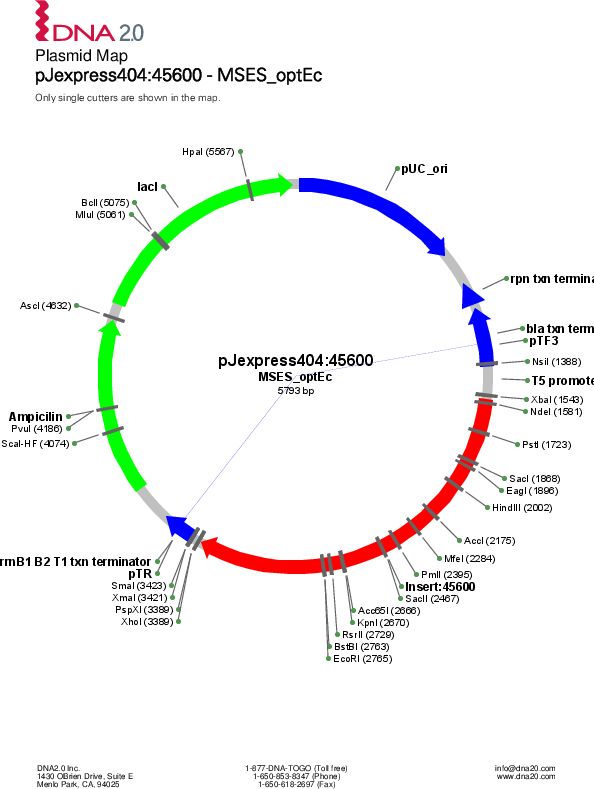-
PurposeBacterial Expression Vector
-
Depositing Lab
-
Sequence Information
Ordering
| Item | Catalog # | Description | Quantity | Price (USD) | |
|---|---|---|---|---|---|
| Plasmid | 49417 | Standard format: Plasmid sent in bacteria as agar stab | 1 | $85 | |
Backbone
-
Vector backboneJpExpress404
-
Backbone manufacturerDNA2.0
- Backbone size w/o insert (bp) 3968
- Total vector size (bp) 5793
-
Modifications to backboneN/A
-
Vector typeBacterial Expression
Growth in Bacteria
-
Bacterial Resistance(s)Ampicillin, 100 μg/mL
-
Growth Temperature37°C
-
Growth Strain(s)Top10
-
Copy numberHigh Copy
Gene/Insert
-
Gene/Insert namePTEN-Long
-
Entrez GenePTEN (a.k.a. 10q23del, BZS, CWS1, DEC, GLM2, MHAM, MMAC1, PTEN1, PTENbeta, TEP1)
- Promoter T5
Cloning Information
- Cloning method Unknown
- 5′ sequencing primer pNI-Rev (CGTTGCTTTTTCGATTGATG)
- 3′ sequencing primer rrnB_T1_term-F (ACGAAAGGCTCAGTCGAAAG) (Common Sequencing Primers)
Resource Information
-
Articles Citing this Plasmid
Terms and Licenses
-
Academic/Nonprofit Terms
-
Industry Terms
- Not Available to Industry
Trademarks:
- Zeocin® is an InvivoGen trademark.
Depositor Comments
The PTEN nucleotide sequence in this plasmid has been codon optimized for expression in bacteria.
These plasmids were created by your colleagues. Please acknowledge the Principal Investigator, cite the article in which the plasmids were described, and include Addgene in the Materials and Methods of your future publications.
-
For your Materials & Methods section:
JpExpress404 PTEN-LONG was a gift from Ramon Parsons (Addgene plasmid # 49417 ; http://n2t.net/addgene:49417 ; RRID:Addgene_49417) -
For your References section:
A secreted PTEN phosphatase that enters cells to alter signaling and survival. Hopkins BD, Fine B, Steinbach N, Dendy M, Rapp Z, Shaw J, Pappas K, Yu JS, Hodakoski C, Mense S, Klein J, Pegno S, Sulis ML, Goldstein H, Amendolara B, Lei L, Maurer M, Bruce J, Canoll P, Hibshoosh H, Parsons R. Science. 2013 Jul 26;341(6144):399-402. doi: 10.1126/science.1234907. Epub 2013 Jun 6. 10.1126/science.1234907 PubMed 23744781





